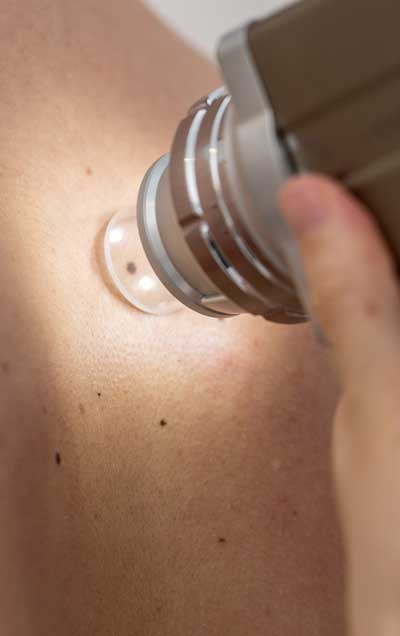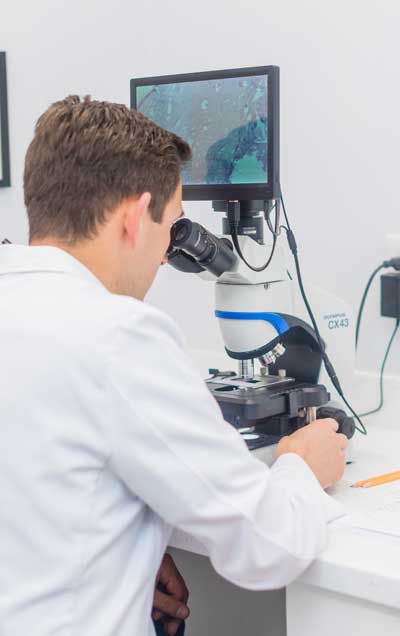Mohs surgery is an advanced minimally invasive surgical technique for skin cancer removal. At the Kentucky Skin Cancer Center, dermatologist Robert Skaggs, MD, FAAD, is a fellowship-trained Mohs surgeon who’s known as a leading skin cancer surgery specialist. To get an evaluation and treatment from an expert surgeon, call the Bowling Green, Owensboro or Franklin, Kentucky, office today.


Mohs surgery is a cancer treatment in which Dr. Skaggs removes tissue in tiny increments, taking only the diseased tissue and leaving your healthy tissue intact. This type of surgery is a far less invasive solution than other therapies like excision, and it also offers thorough cancer removal with a low chance of recurrence.
Only specially trained surgeons can perform Mohs surgery. Dr. Skaggs is a fellowship-trained Mohs surgeon who is widely acknowledged as a Mohs surgery expert.
In Mohs surgery, Dr. Skaggs removes the absolute minimum amount of skin needed to eliminate your cancer. This means you have the smallest possible wound.
Mohs surgery also offers a high cure rate of 96-99%. Most of the time, cancer treated with Mohs surgery doesn’t spread to other areas.
The bottom line is that Mohs surgery can allow for total cancer removal, the first time, instead of multiple conventional treatments.
With conventional treatment, the cure rate for returning tumors can be as low as 50%. However, with Mohs surgery, the cancer is fully removed the first time, and returning tumors are exceedingly rare.


During Mohs surgery, Dr. Skaggs removes a thin layer of skin around the previously biopsied skin cancer and examines the tissue in an onsite lab. When the tissue is turned into a microscope slide he creates a map of your cancer and marks its location before removing the thin layer of tissue in the area where the cancerous cells remain.
This process continues until the tissue is free of cancer cells. Usually, it takes between one and three layers of tissue to get to the root of the cancer and make sure it’s completely removed. If you have large or aggressive cancer, it might take more. Each cycle of laboratory testing takes 45-60 minutes, so you can expect to spend at least half of the day at the Kentucky Skin Cancer Center.
You can read, use your digital device, or even bring a friend along the day of your Mohs surgery to make the day go by quickly. It’s exceedingly rare, but in particularly complex cases, you might need to return for a second day of Mohs surgery.
Book your Mohs surgery appointment by calling the Kentucky Skin Cancer Center location nearest you now.
Mohs surgery is a cancer treatment in which Dr. Skaggs removes tissue in tiny increments, taking only the diseased tissue and leaving your healthy tissue intact. This type of surgery is a far less invasive solution than other therapies like excision, and it also offers thorough cancer removal with a low chance of recurrence.
Only specially trained surgeons can perform Mohs surgery. Dr. Skaggs is a fellowship-trained Mohs surgeon who is widely acknowledged as a Mohs surgery expert.
In Mohs surgery, Dr. Skaggs removes the absolute minimum amount of skin needed to eliminate your cancer. This means you have the smallest possible wound.
Mohs surgery also offers a high cure rate of 96-99%. Most of the time, cancer treated with Mohs surgery doesn’t spread to other areas.
The bottom line is that Mohs surgery can allow for total cancer removal, the first time, instead of multiple conventional treatments.
With conventional treatment, the cure rate for returning tumors can be as low as 50%. However, with Mohs surgery, the cancer is fully removed the first time, and returning tumors are exceedingly rare.
During Mohs surgery, Dr. Skaggs removes a thin layer of skin around the previously biopsied skin cancer and examines the tissue in an onsite lab. When the tissue is turned into a microscope slide he creates a map of your cancer and marks its location before removing the thin layer of tissue in the area where the cancerous cells remain.
This process continues until the tissue is free of cancer cells. Usually, it takes between one and three layers of tissue to get to the root of the cancer and make sure it’s completely removed. If you have large or aggressive cancer, it might take more. Each cycle of laboratory testing takes 45-60 minutes, so you can expect to spend at least half of the day at the Kentucky Skin Cancer Center.
You can read, use your digital device, or even bring a friend along the day of your Mohs surgery to make the day go by quickly. It’s exceedingly rare, but in particularly complex cases, you might need to return for a second day of Mohs surgery.
Book your Mohs surgery appointment by calling the Kentucky Skin Cancer Center location nearest you now.
Related Services
Your Trusted Skin Cancer Experts
Ask our team today how we can help you have the healthy skin you deserve!
The Kentucky Skin Cancer Center is a comprehensive dermatology practice offering the best in surgical dermatology, general dermatology, pediatric dermatology, and cosmetic dermatology.